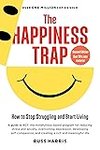
Saved by Harold T. Harper and
The Happiness Trap

Saved by Harold T. Harper and
In psychology jargon, the technical term for what you’ve just been doing is exposure. (In everyday language, we use terms like facing your fears or leaving your comfort zone.) Exposure means deliberately getting in contact with difficult stuff so that you can learn more effective ways of responding to it. This difficult stuff may be in the external
... See more“So whether your thoughts are true or not isn’t the issue here. The point is, if you let them push you around, that’s not helpful. So
All you need do is pick one or two values every day and look for opportunities to “sprinkle” them into your activities.
The aim is not to get rid of unpleasant thoughts but rather to see them for what they are—simply words—and drop the struggle with them.
those are qualities of behavior you desire, then we’d call them “values.”
In OBEY mode, we give our thoughts our undivided attention or treat them as commands we must obey or regard them as the absolute truth. The technical term for responding to our thoughts in this way is fusion.
our aim here is to do something totally different: to step out of that struggle with thoughts and feelings and allow them to be as they are; to let them “rest in our lap” and allow them to come, stay, and go in their own good time.
To say we are “hooked” by (or “fused with”) our thoughts basically means they dominate us.
emotions are comprised of two interweaving elements: cognitions and sensations.